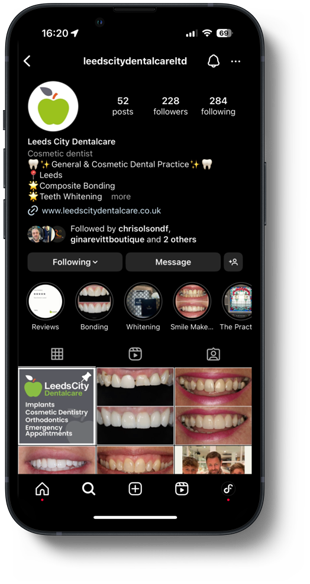An effective long-term solution to straightening your teeth and correcting your bite is orthodontics. Orthodontics is a subspecialty area in dentistry that focuses on aligning and straightening teeth using wires and brackets, applying gentle pressure to the teeth to move them into a particular position. The discipline has advanced over decades and today treatment is a lot faster and more comfortable than it was in the past.
"I couldn't thank and recommend Leeds City Dentalcare enough! From the start of my orthodontic treatment I always felt comfortable, my dentist Lee was very patient, answered my questions and explained all of the procedures in a lot of detail, and I always knew what to expect. I am very pleased with the results of my treatment and now I can smile with confidence :) All nurses and receptionists are very friendly and helpful too, and I couldn't be more thankful for the brilliant care I received!"

Orthodontics is a branch of dentistry that focuses on the diagnosis, prevention, and correction of dental and facial irregularities. Orthodontic treatment involves the use of braces, wires, and other appliances to straighten teeth, correct bite problems, and improve dental and facial aesthetics.
Braces can be uncomfortable, but they shouldn't be painful. Most people experience some soreness or discomfort for a few days after the braces are first placed and after each adjustment appointment. Over-the-counter pain medications, such as ibuprofen, can help alleviate any discomfort.
The length of orthodontic treatment varies depending on the severity of the dental and orthodontic issues being addressed. The average treatment time for traditional metal braces is two to three years, but some cases may take longer or shorter.
There are several different types of braces available, including traditional metal braces, ceramic braces, lingual braces, and clear aligners. Traditional metal braces are the most common and most affordable option. Ceramic braces are similar to metal braces, but the brackets are made of tooth-coloured material, making them less noticeable. Lingual braces are placed on the back of the teeth, making them virtually invisible. Clear aligners, such as Invisalign, are a series of clear plastic trays that gradually move the teeth into position.
During active orthodontic treatment, you will typically need to see the orthodontist every four to six weeks for adjustments. These appointments are important to ensure that the braces are working properly and to make any necessary adjustments to the treatment plan.
Yes, wearing a retainer is an important part of maintaining the results of orthodontic treatment. After the braces are removed, the teeth will naturally want to shift back to their original positions. A retainer is used to hold the teeth in their new position until they become more stable. The orthodontist will provide instructions on how often to wear the retainer and for how long.
Orthodontic treatment may require some adjustments to your daily activities, particularly in the first few days after the braces are placed. You may need to avoid certain foods that are hard or sticky, and you may need to spend a little extra time caring for your teeth and braces. However, most people are able to continue their normal activities, such as playing sports and musical instruments, during orthodontic treatment.
It is common to experience some changes in speech during the first few days after braces are placed or adjusted. You may notice a slight lisp or difficulty pronouncing certain sounds. However, most people adjust to the braces quickly and speech returns to normal within a few days.
The cost of orthodontic treatment varies depending on the type of braces used and the length of treatment. Traditional metal braces are typically the most affordable option, while clear aligners are usually the most expensive. Many orthodontic offices offer payment plans and financing options to make treatment more affordable.






Stay connected with us on Instagram to discover the latest practice news and explore our stunning cases.
FOLLOW US
Leeds City Dentalcare
159 Beeston Road, Leeds LS11 6AW
| Monday | 8:00 am - 5:00 pm |
| Tuesday | 8:00 am - 5:30 pm |
| Wednesday | 8:00 am - 5:00 pm |
| Thursday | 8:30 am - 6:00 pm |
| Friday | 8:00 am - 4:00 pm |